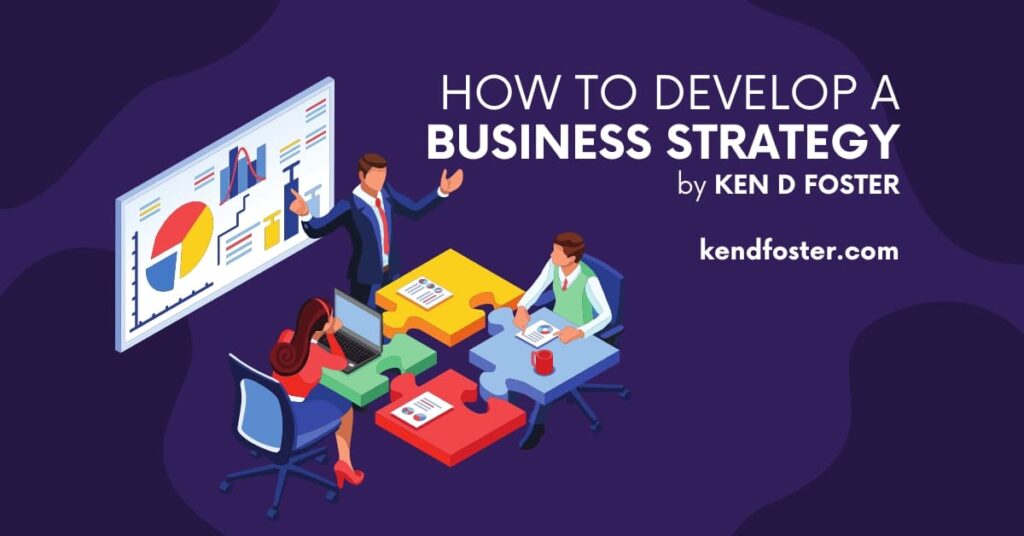
If you want to grow your business in this competitive world, it’s necessary to have an effective business strategy. Without a business strategy, you may be able to meet your short-term goals, but you can’t sustain the competition in the long run.
A strategy can make or break your business. So, in this article, let’s discuss how to develop a business strategy in detail.
What Is a Business Strategy?
A business strategy is a plan you create to help a business achieve its goals. It’s formed by considering all departments of a company, such as operations, management, finance, marketing, sales, and human resource. While developing the strategy, you should also consider the mission and vision of your business.
There are three types of business strategies, and all of them are necessary to grow your business.
- Corporate-level strategy is a long-term strategy that mainly focuses on achieving long-term goals. It’s usually formed by a company’s top-level executives.
- Business-level strategy, also known as competitive strategy, is created to keep a company ahead of its competition.
- Functional-level strategy is a short-term strategy that focuses on the day-to-day activities of a business.
Importance of Business Strategy
Here’s why developing a business strategy is crucial for the success of a business.
- It’s necessary to create a plan.
- It helps in identifying strengths and weaknesses.
- It gives you control over your day-to-day business activities as you will know what to do next.
- It’s necessary to measure success.
- It gives you a competitive advantage over your competitors who don’t have one.
Tips To Develop a Business Strategy
Here are the tips that can help you build an effective business strategy.
- Identify the mission and vision of your business
- Perform a SWOT analysis
- Identify your competition
- Set goals
- Create a plan
- Measure the results
1. Identify the Mission and Vision of Your Business
If you don’t have your business’s mission and vision statement, prepare it first. It’s the key to developing a business strategy.
The mission of your business is its objectives. It should help in the day-to-day activities of your business and be in a way that supports the vision. For example, Microsoft’s mission statement:
“To empower every person and every organisation on the planet to achieve more.”
The vision of your business refers to what you aim to achieve, though it may take several years. It should represent how you want your company to be in the future and should be inspirational to your team. For example, IKEA’s vision statement:
“To create better everyday life for the many people.”
2. Perform a SWOT Analysis
Performing a SWOT analysis of your company can help you identify its Strength, Weakness, Opportunities, and Threats. In other words, it can help you know:
- The areas where you exceed
- The areas where you need to improve
- The opportunities that you can utilise for faster growth
- The threats that can potentially affect your business
If you have just started your business, identify your target market to know who will consume your product or service. Knowing your target market is necessary to identify opportunities and threats.
3. Identify Your Competition
Once you find your target market, you should next identify your competition. Learn from established competitors and do what it takes to be the best.
Always remember that customers will only buy one of the two same products, so it’s necessary to make your product stand out. Initially, attractive pricing can help your product to reach out to people. People who like the quality of your product will become recurring customers.
4. Set Goals
Setting goals gives you and your employees a clear idea of what to achieve, which, as a result, helps you to stay focused and motivated. The goals you set for your business should be related to the mission and vision.
How to set goals
Apply the S.M.A.R.T. strategy when setting goals for your business. S.M.A.R.T. stands for Specific, Measurable, Achievable, Relevant, and Time-bound.
- Specific: If you specify your targets, the entire team will know what to achieve and will work towards it.
- Measurable: Set quantifiable goals to track the progress and know whether you and your team have actually achieved them.
- Achievable: Aim big, but don’t set unrealistic goals. Don’t aim to make a million dollars in the first month of starting your business. That’s unrealistic!
- Relevant: Set goals that are relevant to your company. They should be based on your mission and vision statement.
- Time-bound: Set a time limit to achieve the goals so your team will work more effectively towards reaching the targets.
5. Create a Plan
Now that you have set a goal, the next step is to create a plan to achieve it. A plan should include the tasks that help in achieving your goals. When formulating a plan, consult with your team and solicit their feedback, as they will be the ones to carry it out. You can update your plan as needed.
6. Measure the Results
Setting goals and creating a plan to achieve them will not alone guarantee success. Track the progress at least every week to ensure everything goes according to the plan. Check to see if your employees are completing their tasks. If something needs improvement, take the necessary steps to correct them.
Conclusion
A business strategy is a blueprint that helps your company achieve its goals. Many businesses don’t have a business strategy, so developing one gives you a headstart over them.
As a business owner, it can be overwhelming to handle everything yourself. If you need help forming a business strategy, get in touch with the expert, Ken D Foster, who has over 35 years of experience as a business coach. Besides creating a business strategy, Ken can also help you grow your business faster.


